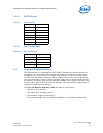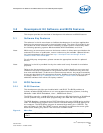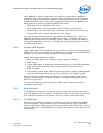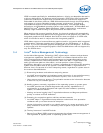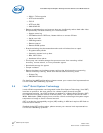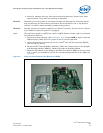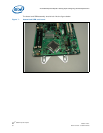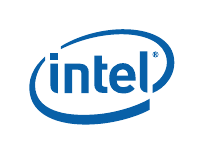
Intel
®
Q965 Express Chipset
October 2007 DM
Order Number: 315664-002US 28
Development Kit Software and BIOS Features—Intel Q965 Express Chipset
Using SMBIOS, a system administrator can obtain the system types, capabilities,
operational status, and installation dates for system components. The MIF database
defines the data and provides the method for accessing this information. The BIOS
enables applications such as third-party management software to use SMBIOS. The
BIOS stores and reports the following SMBIOS information:
• BIOS data, such as the BIOS revision level
• Fixed-system data, such as peripherals, serial numbers, and asset tags
• Resource data, such as memory size, cache size, and processor clock frequency
• Dynamic data, such as event detection and error logging
Non-Plug and play operating systems such as Microsoft Windows NT*, require an
additional interface for obtaining the SMBIOS information. The BIOS supports an
SMBIOS table interface for such operating systems. Using this support, an SMBIOS
service-level application running on a non-Plug and Play operating system can obtain
the SMBIOS information.
3.2.4 Legacy USB Support
Legacy USB support enables USB devices to be used even when the operating system’s
USB drivers are not yet available. Legacy USB support is used to access the BIOS Setup
program, and to install an operating system that supports USB.
Legacy USB support operates as follows:
1. When you apply power to the computer, legacy support is disabled.
2. POST begins.
3. Legacy USB support is enabled by the BIOS allowing you to use a USB keyboard to
enter and configure the BIOS Setup program and the maintenance menu.
4. POST completes.
5. The operating system loads. While the operating system is loading, USB keyboards
and mice are recognized and may be used to configure the operating system.
After the operating system loads the USB drivers, all legacy and non-legacy USB
devices are recognized by the operating system, and Legacy USB support from the
BIOS is no longer used.
To install an operating system that supports USB, follow the operating system’s
installation instructions.
3.2.5 Boot Options
In the BIOS Setup program, the user can choose to boot from a diskette drive, hard
drive, CD-ROM, or from the network. The default setting is for the Hard Drive to be the
first, and the CD-ROM to be the second. There is no third or fourth boot option.
3.2.5.1 CD-ROM Boot
Booting from CD-ROM is supported in compliance to the El Torito bootable CD-ROM
format specification. Under the Boot menu in the BIOS Setup program, CD-ROM is
listed as a boot device. Boot devices are defined in priority order. Accordingly, if there is
not a bootable CD in the CD-ROM drive, the system will attempt to boot from the next
defined drive.







